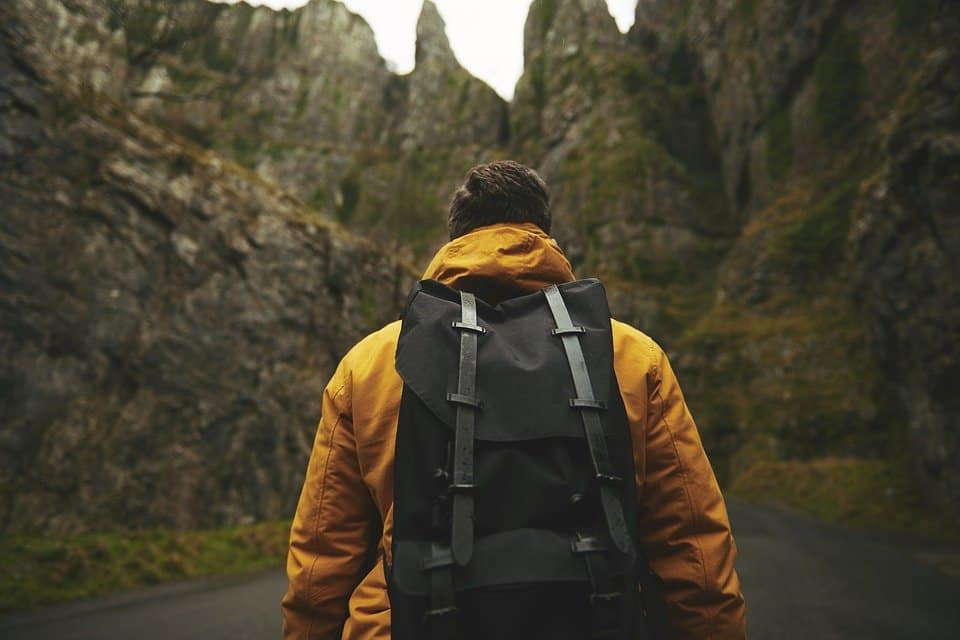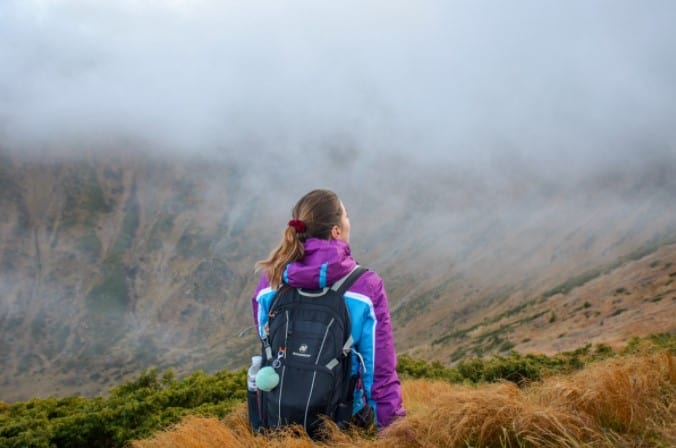Packing your backpack may seem like an easy task. However, getting things in and out of your backpack throughout your hike can either be fairly easy or extremely difficult. It all depends on how much thought you put into packing your pack and can make a huge difference.
An improperly packed backpack can cause a ton of issues. You can end up hurting yourself, making the hike much tougher than it should be, or simply waste time digging through a cluttered pack. Things that you don’t want to worry about when trying to go for a fun hike.
Table of Contents
Impact Of A Improperly Packed Backpack:
You could strain your back.
If you put things of different weights in the wrong place it can really weigh you down. Causing your back to become unaligned. Heavy objects packed poorly can also put a ton more weight on your shoulders making your pack feel heavier than it actually is.
The backpack can throw you off balance.
If your items are not packed in the correct spot inside, the backpack can actually throw you off balance. Especially if you are going up or down steep slopes, which can be really dangerous. Additionally, simply not having everything compact enough can cause shifting and can also throw you off balance.
You’ll spend a lot of time unpacking and repacking
If you don’t think carefully about where things should be packed into your pack, you could be wasting a ton of time searching for things you may need. For example, if you put something you may need often at the bottom of your pack, you will need to take everything out to get to it. Which is extremely irritating.
If you’ve ever gone backpacking and just threw all of your belongings inside anyway they fit, you know how much easier proper organization can make your hike. Organizing your backpack in a specific way can make your pack feel lighter and make retrieving things throughout the hike much more sufficient.
Key Factors To Consider When Packing:
Where the items could possibly fit. Your backpack most likely has many pockets and compartments. Think about where your larger items, such as your camping gear could fit. Also, think about where your smaller items may fit without moving around too much. It may be wise to get small zippered bags for small items also.
How heavy it is
Heavier items need to be placed in a specific place in your pack so that the weight is not throwing you off balance. Divide your heavier items, like your cooking implements and food from the lighter objects. They will need to be bundled together.
How often you will use each item
In order to make accessing the things in your pack as easy as possible, you will need to think about what you will be needing most and least. The things you use only once a day, including your camping gear, will not need to be very accessible. Snacks, jackets, and other items you may need throughout the day will need to be easily accessible.
How to Pack
With the basic guidelines listed above in mind, here is an exact breakdown of how my backpack is packed for a hiking trip. Some of you may not need as much or may need a little more. Nevertheless, if you consider all that you’re packing and use this breakdown below, accessing the things inside your backpack will be much more sufficient.
Less used items go near the bottom
Anything you only plan to use once a day or less should go on the bottom of your pack. This includes all of your camping gear. You will only be getting it out in the evening when you are setting up for camp at the end of the day.
The first thing to go into your backpack should be your sleeping bag. It’s the last thing you will take out when setting up camp and the first thing you’ll need to put away when taking down camp. My backpack has a separate compartment on the bottom just for a sleeping bag.
The next things should be your sleeping pad, tent, pillow, and other alike things. These can be slid in upright since they are probably too tall to fit in laying flat. If all of these things don’t fit inside with all of your other things, the tent and/or the sleeping pad can most likely be attached to the outside of your backpack with provided straps on the top or bottom.
Heavier items go near the center close to your back
All of your heavier things should be placed compactly into the center of your backpack close to your back. They should be directly aligned with your spine. This gives you more of a centered balance while hiking with your backpack.
Cooking gear is usually the heaviest items you carry while backpacking. This includes cookware, utensils, your stove, and gas. Make everything as compact as possible by stacking cookware with the stove, gas, and utensils packed inside your pot.
Food may also be really heavy, so make sure it is near the center and close to your back as well. Pack all of your food into a zippered pouch or a bear-resistant food container if you are hiking in bear country. This just keeps it all organized.
Other items that are very heavy include electronics like cameras, cell phones, and portable batteries. You may want to carry your cell phone or camera in an outside pocket for easy access. However, your batteries can be packed with your other heavy items.
Lighter items go away from your back
Your lightest items can be packed away from your center back around your heavy items. You want everything to be close together so that there isn’t too much shifting. Packing in lighter items around your heavy items is a good way to prevent this.
These lighter things should be things that you are only going to use once or twice a day. They will not be on the very top. Therefore, they are not super accessible, but manageable enough to get out a couple of times throughout the day.
Lighter items to pack around your cookware and other heavy items could be toiletries, underwear, socks, and a microfiber camping towel. All of these items would be good to keep in separate pouches as well. Separate pouches make them much easier to find and less likely to move around.
Most used items go near the top
Your larger items that will not fit inside-outside pockets, but are still possibly needed a number of times through the day go on the top. You want to be able to take it out and put it back in with zero hassle. These should also be lightweight items so you do not get too top-heavy.
Jackets, an extra pair of socks, and a rain cover for your backpack would all be good items to put at the top of your main compartment. You never know when you could get a little too wet or too hot or cold. You will probably be needing these things throughout your hike multiple times.
You can also throw your water filtration system on top. Depending on what kind of filtration system you have, this could be put in many places. If it’s large and heavy, you may want it near you back. If it is small and light, it could either go on the top of the main compartment or in an outside pocket.
Items you need handy at all times go on the outside
Almost any backpack you purchase will have an assortment of pockets on the outside. Some zippered, some mesh open pockets, and some mesh snap pockets. Anything you may want to grab easily without having to set down your backpack every time should go in these pockets.
You are going to need a lot of water, so your water bottle should definitely go in an outside mesh pocket. Preferably one on the side of the pack that you can easily reach around and grab and put back. Trekking poles would be another good item to put in a side mesh pocket.
Any zippered or snapped pockets could hold a hat, sunglasses, a compass, map, first aid kit, or a camping knife. These things are small enough to fit in these compartments and will most certainly be needed throughout your hike. Although, you may have to put your pack down to get into these zippers
Tighten compression straps as much as possible
Make sure that everything inside your pack is packed close together and organized properly. When everything inside is where you would like it, tighten your compression straps. These are locate
don the outside of your pack usually in four to six places.
Tightening your compression straps keeps everything in place. If things aren’t tightly squeezed together they could shift around. Shifting causes your pack to bounce around, which could throw you off balance and make your hike much more difficult.
Plus, your pack will look much more narrow and sleek when everything is held tightly together. You can check your compression straps to make sure they are tight each time you stop to get something out.
Looking For A Great Hiking Backpack?
The backpacks photographed in this article are great backpacks and have been used by me and other people for years. One is larger and is great for long backpacking trips. The other is a bit smaller, which is plenty for small weekend hiking trips. The backpacks are:
With a properly packed backpack, your hike should be fairly simple and fun! You won’t have to spend the majority of your hike digging through your bag because you can’t find something. When you get home you’ll be able to relax without the worry of back pain from an unbalanced backpack. Use these tips and enjoy your hike!
Further read:
- https://alloutdoorsguide.com/best-dehydrated-backpacking-meals-bring-next-trip/
- https://alloutdoorsguide.com/how-to-select-the-best-water-filter-system-for-backpacking/

The All-Outdoors Guide team is comprised of enthusiastic experts that enjoy helping others that aspire to be better at outdoor fun. Part of that is making sure you have the right gear and information when it’s time to go out and have fun. Some of our team have accomplished amazing feats like climbing 6000 feet to the top of mountains, others have explored every dirt trail they could find and we even have some people that have backpacked solo on various continents. No matter what our readers want to learn and do, our team is here to help them accomplish those goals.




